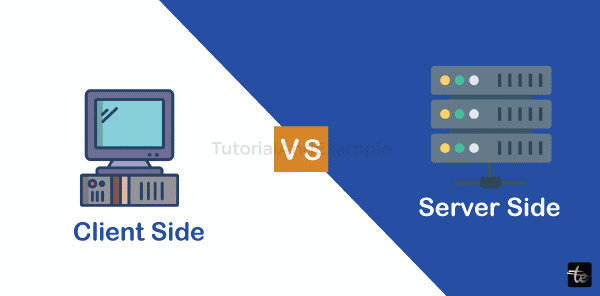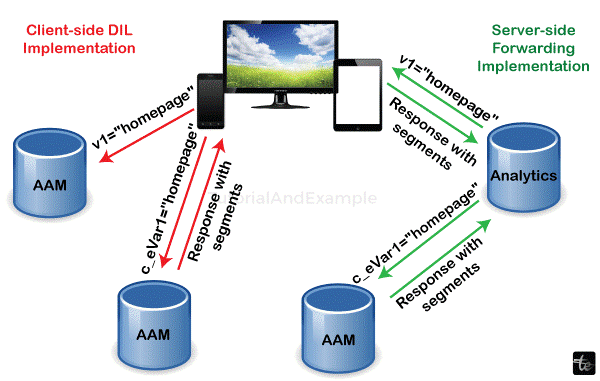What is Server-Side Programming?
Server-side programming or Server-side development is also called back-end development. It is a type of development that involves programs that run on the server. This type of programming is important because web browsers, or clients, interact with web servers to fetch information. In this article of server-side programming, we address some questions like, "What is it?" "How is it different from client-side programming?" and "Why is it so useful?" You will comprehend the additional capability that server-side coding gives websites after reading this article.
The majority of large-scale websites employ server-side programming, which pulls data from a database that is kept on the server and sends it to the consumer to be displayed via code (such as HTML and JavaScript) as needed.
Customising website content for specific visitors is arguably the biggest advantage of server-side scripting. More appropriate information can be highlighted on dynamic websites depending on user choices and behaviours. Additionally, it may make websites simpler to use by saving user preferences and data. For instance, it might reuse saved credit card information to expedite further payments.
It is strongly suggested to learn about server-side development in the current web development market.

It may also facilitate communication between site visitors and itself by sending email alerts and updates, among other things. These features all allow for far more in-depth interaction with consumers.
How can you address the Server-Side Issue?
Because server-side programming makes it possible to offer information customised for each user effectively, it greatly improves the user experience.
Banks save account information via server-side programming, limiting access to transactions to only authorised users. Server-side programming is used by Wikipedia, Twitter, Facebook, Instagram, and other sites to identify, distribute, and manage access to noteworthy material.
Effective Information Delivery and Storage
Instead, we may store the data in an SQL database and create the returned HTML and other file kinds (such as PDFs and pictures) dynamically thanks to server-side scripting. Additionally, data (JSON, XML, etc.) can be returned so that suitable client-side web frameworks can display it; this lessens the quantity of data that must be provided and the processing load on the server.
Just consider the sheer volume of goods on Amazon and the sheer volume of posts on Facebook. It would be utterly impracticable to create a different static page for every product or topic.

The information may be communicated and maintained with different company applications more readily since it is stored in a database. For instance, a shop may update its inventory database when things are sold online or in person.
The information that the server can deliver is not restricted to data from databases; it can also return information from communications services or software tools. Even the kind of client device receiving the material can be targeted.
Personalised User Interface
In order to offer a pleasant and customised user experience, servers can retain and utilise client information. For instance, a lot of websites retain credit card information so that it doesn't need to be input again. Websites such as Google Maps can promote local businesses in outcomes of searches by using search or trip history, and they can also use stored or current locations to provide routing information.
In order to anticipate users' interests and further tailor answers and notifications for instance, by presenting a map with a list of frequently visited or well-liked sites you might want to check out a more thorough examination of user behaviour is necessary.
Restricted Content Access
Websites can limit access to authorised users and only display the content that a user is allowed to view, thanks to server-side scripting.
Examples from the real world are social networking sites where users control who may view the stuff they upload and what content shows up in their feed.
Save Session and State Data
Developers may employ sessions, which are a technique that lets a server retain data related to the current client of a site and deliver various replies based on that data, by using server-side programming.
This enables a website, for instance, to recognise that the user has visited it before and provide connections to their order history or emails. It may also save the current situation of a straightforward game in order to ensure the user can return to the website and continue where they left off.
Alerts and Correspondence
Servers can employ email, SMS, instant messaging, video chats, and other communications services to send out general or user-specific notifications in addition to the website itself.
Here are a few instances:
- You may receive messages via SMS or email from Facebook and Twitter alerting you to new messages.
- Amazon frequently sends you product emails that recommend items you find interesting that are similar to ones you have already purchased or seen.
- Site managers may get warning messages from a web server informing them of limited server memory or questionable user behaviour.
What Is Client-Side Development
Two key ideas in software and web development are client-side and server-side development. The goals and programming languages used in these kinds of development vary greatly.
Programming that runs on a client's or the consumer's device is known as client-side programming, also sometimes called front-end development. Developers working on client-side projects concentrate on building the user-interactive portion of websites.
This kind of development concentrates on the user-facing portion of a program. Client-side developers work on a range of projects, such as:
- Layout websites
- Creating user interfaces
- Including validation in forms
- Evaluating the functionality of websites and using visual design components like fonts and colours
- Increasing the functionality of website features
- Fixing any problems consumers may have with a website
Languages Used in Client-side Programming
Individuals who work in fields such as user experience design and web design prioritize client-side development.
Programming languages that are tailored to client-side development include:
- Hypertext Markup Language: HTML is the common language used in online development.
- Cascading Style Sheets: CSS, for short, is a design language used by developers to add visual design components to HTML-coded websites. Developers may utilize CSS to improve the visual attractiveness of their websites on consumers' devices.
- JavaScript: Web development, web apps, and other uses for this programming language are available to developers. Developers may create dynamic, interactive webpages with JavaScript.
- VBScript: Some browsers support the client-side scripting language known as VBScript. VBScript is a tool that developers may use to give webpages interactive components.
What is Server-side Development?
Programs that operate on a server are the subject of server-side development, sometimes referred to as back-end development. Because browsers, also called browsers or clients, communicate with internet servers in order to collect information, this kind of programming is crucial. Because this evolution takes place on servers, users are unaware of it.
Typical server-side jobs consist of:
- Developing dynamic web pages
- Making web apps
- Linking webpages to databases
- Putting content management systems in place
- Ensuring that software accurately retrieves data and that systems are protected from hackers
- File backup and restoration
Languages for Server-side Programming
Server-side development is generally used by web developers, database managers, and software developers.
Numerous programming languages are available to server-side developers, including:
- Java: Developers may use the object-oriented Java programming language for creating software and applications, among other things.
- Python: It is a general-purpose, object-oriented programming language that programmers may use to create operating systems, websites, applications, and other things. Applications for Python may be found in data science, economics, and other areas of computers.
- Structured Query Language: SQL is the industry-standard vocabulary for communicating with databases.
- PHP: Web developers utilize PHP, an acronym for Hypertext Preprocessor, as a programming language to build pages and web applications. Database connections may be made with PHP to show material on web pages.
Server-side versus Client-side Development
Full-stack developers are programmers who are proficient in both client-side and server-side programming, which are essential for the smooth operation of websites and apps.
The following are some significant distinctions between server-side and client-side development:
Where is the code executed?
Where code executes is one of the main distinctions between server-side and client-side programming. The code is executed on a customer's or user's device in client-side development. Code that is developed server-side passes via a server.
Writing Scripts
Another distinction between server-side and client-side programming is the manner in which scripts are executed. Scripts that are client-side scripting execute on a device. Client-side scripts typically operate in a browser. Server-side scripts, on the other hand, operate on a web server.
While server-side development takes place in an environment invisible to users, client-side development is typically user-focused. The components of an application or web page that consumers can view, such as graphic designs and webpage layouts, are the primary focus of client-side developers.
Server-side programmers concentrate on more obscure elements, including the data transmission protocol between an application and a server. While code running on the server is transparent to the user, client-side code is frequently visible.
Objective
Additionally, the goals of server-side and client-side programming differ. Creating visual effects and aspects for websites, such as layouts and user interfaces, is the main objective of client-side development. Server-side development involves duties such as getting data from a web server and communicating with databases in order to concentrate on the true substance of a webpage.